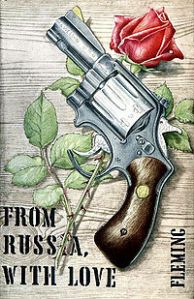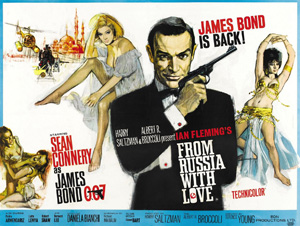From Russia with Love, Ian Fleming’s fifth James Bond novel bolts past its predecessors. The format, language and characters shift on a new track as it brings Bond to his most exotic location yet — Istanbul. The novel manifests more gadgets and violence that would become staples in the series both on paper and on the silver screen. Fleming also grants greater insight into Bond’s life — when he is not routing his foes. It is no surprise that this is the quintessential Bond book that helped popularize the series, and according to Time Magazine and the John F Kennedy library it was one of the former Presidents favorite books.
This is the first Bond novel that is truly written in multiple parts, “The Plan” and “The Execution.” Although Moonraker (1955) is separated into three parts it only serves the purpose of separating the three days over which the story takes place. From Russia with Love there is a massive change in format that foreshadows a conspiracy against Bond, opposed to a plot that he must foil as is the case in the previous novels.
The first half of the novel introduces SMERSH and its operators. Fleming writes, “SMERSH is the official murder organization of the Soviet government.” A contraction of two Russian words, SMERSH translates to “death to spies”. It consists of several Soviet intelligence and security ministries such as the MGB (the predecessor of the KGB). As in many bond novels, realty blends with fiction for great story telling; SMERSH, despite its cartoonishly ominous name, was a real organization, although it possibly disbanded by the time the novel was written (1956). This is the third Bond novel to involve SMERSH; the others being Casino Royale (1953) and Live and Let Die (1954).
It is no good killing a man unless you also destroy his reputation
In the novel, SMERSH constructs a plan to dispose of Bond and humiliate the British Secret Intelligence Service. They set in motion a trap to lure Bond with a woman who wants to defect and bring over a Spektor machine — the highly coveted Soviet cipher machine. This introduces Tatiana Romanova, a young MGB Corporal, who is instructed to fall in love with Bond in order to deceive him, hence the book’s title. Romanova lives up to other bond girls: she is beautiful, seductive, and dangerous. But most importantly it’s hard to tell whose side she is on, which is reminiscent of the first bond girl Vesper. In fact Tatiana’s surname is that of the last Royal family of Russia that were brutally executed during the 1917 Bolshevik revolution. This family name reinforces her duplicitous nature. Is she truly a Soviet or a double agent?
Fleming begins the second half of the novel a year after the events of Diamonds are Forever (1956). Tiffany Case, the last Bond girl, has left him, and “the blubbery arm of the soft life had Bond round the neck and they were slowly strangling him” (95). Bond here is weary from dullness, but more noteworthy he is suffering from heartbreak. Miss Case has left him for another man, and Bond acknowledges this is the source of his pain. Fleming also depicts the drudge of Bond’s routine. It is these early scenes of the second part of the novel that grants a glimpse into Bond’s life in London. This also highlights one of the better aspects of the novels over the films: James Bond is not a superhero. He loses, suffers and scars — scars that are highly visible. Later in novel Bond is disgusted by a murder that involves him, “Bond had never killed in cold blood, and he hadn’t liked watching, and helping, someone else do it” (175). This reveals a dimension of Bond that is unfamiliar. He finds the violence in his craft repulsive — he values human life. He questions why he sacrifices so much for his country and ponders why he cannot have lasting relationships with people.
Fleming ends an early chapter, “a curious quotation slipped from nowhere into Bond’s mind. Those whom the God wish to destroy, they first make bored.” This beautiful summarizes the lethargic state of Bond, and illuminates the talent of Fleming. He has Bond intentional misquote an old proverb, and at the same time Fleming reinvents it.
Q pulls out its first bag of tricks in this book — literally and figuratively. First off, Q is not a singular person as most often portrayed in the films by Desmond Llewelyn. Secondly, Q simple stands for quartermaster, and is a branch of the Secret Intelligence Service. Q branch has made appearances before but this time it develops its first significant gadget: an attaché case that hides all of the following: 50 rounds of .25 ammunition, a throwing knife, a cyanide pill, 50 gold sovereigns, and silencer for Bond’s Beretta. All told not bad for Q in 1957.
I quite agree with you about the Russians. They simply don’t understand the carrot. Only the stick has any affect
This is the first Bond novel set in a distant land. Fleming takes Bond to Istanbul where the East and West meet and the spy games differ immensely. Fleming writes of Istanbul like a travel guide revealing the hidden world of this ancient city, as Bond traverses a secret cavern beneath the Great Horn and is welcomed to a feasting Gypsy camp that becomes embattled by a Soviet allied gang. Fleming brings the story onto the historic Oriental Express that travels from Istanbul to Paris. These trains scene are possibly the best of the novel, as Fleming distorts the characters aboard causing the reader to question when the trap will be sprung, which leads to Bond becoming the first literary spy to fight on a train: a motif now commonplace in spy or action stories.
SPOILERS
Farewell, Mister Bond…. Count on SMERSH to have the last word.
What is likely the most unsettling event in the novel is the conclusion. When Bond finally foils the plot to assassinate him, he goes after his would-be assassin’s handler who is waiting in a hotel in Paris. This SMERSH agent, Rosa Klebb, kicks Bond in the shin with a retractable boot knife hidden in her sole that poisons him. Bond doesn’t realize he is poisoned as he is speaking to a fellow agent, the book concludes on him talking of his lovely Tatiana Romanova as he buckles to the ground. The book closes with James Bond dying on the floor. This ending departs drastically from the previous novels. Although Fleming began writing the sequel soon after finishing this novel, to the public Bond’s fate was unclear.
A little trivia
The film version of From Russia with Love is the closest adaption of any of the novels in both story and events: one change is substituting SMERSH for SPECTRE, an organization not yet invented in the series. The most significant change from is that Bond is not poisoned at the finales although Rosa Klebb does try to stab him with the boot knife. According to Rotten Tomatoes, it is the highest rated of the Bond films.
The TV series Archer borrows heavily from Bond films and novels. The Archer character Katya Kazanova is an homage to Romanova, on top of their physical descriptions, they both fall in love with their respective spies and defect from Russia.



